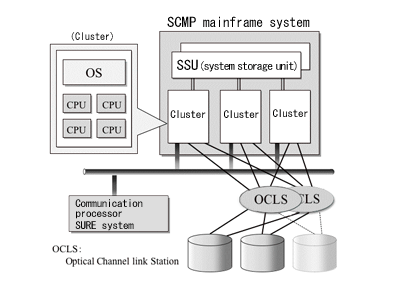In September 1995 Fujitsu began shipping an enhanced version of its OSIV/MSP operating system (first announced in June 1989) for Fujitsu very-large mainframes. The functional enhancements were intended to further improve the scalability of mainframe systems using system storage units (SSUs).
At the time, Fujitsu switched from introducing operating system enhancements as version-level upgrades. Instead, it provided them along with enhanced software in the same way as function revisions. The reason for this was twofold: to reduce the overhead associated with version-level upgrades and because it was impossible to discuss the functions wanted in mainframe systems without considering the relationship between functional enhancements to the operating system and at the middleware level (software such as Fujitsu AIM).
Systems using a SSU to form multi-cluster configurations first appeared with the M-1800 model group, which was announced in September 1990. Fujitsu called these multi-cluster systems system-storage-coupled multi-processor systems (SCMPs). An SCMP joined together multiple tightly coupled multi-CPU systems, called clusters, with parallel technology and a SSU. The SSU was used for inter-cluster communications and as a high-speed “hangar” for data to be shared between clusters. Typical data shared between clusters included such data as control information for databases.
The far-ranging enhancements made to OSIV/MSP in September 1995 made future SCMP scalability increases possible. Initially (at the time of the first SCMP announcement in September 1990), the largest SCMP had 16 CPUs (in a four-cluster configuration). This increased to 32 CPUs (four CPUs x eight clusters) with the GS8000 series (announced in May 1995), 96 CPUs (12 CPUs x eight clusters) with the GS8800 model group (announced in January 1998), and finally 256 CPUs (16 CPUs x 16 clusters) with the GS8900 model group (announced in October 1999). OSIV/MSP covered all these expansions. The same functional enhancements were also supplied with Fujitsu’s large mainframe operating system, OSIV/XSP.
In addition to greater scalability, SCMP systems with a SSU made it possible to construct highly reliable systems for mission-critical systems. The figure below illustrates such a system. The description of the figure is as follows.
- SURE was a continuously operating communication processor containing multiple processing elements (PEs). SURE processors were first supported with the OSIV/MSP enhanced version announced in September 1990.
- SSU-coupled clusters could share databases at high speeds and enable continuous service operation by reserving one cluster as a hot-standby cluster.
- Path redundancy and live maintenance for the disk system was also possible via optical-channel-linked stations (OCLS).*


